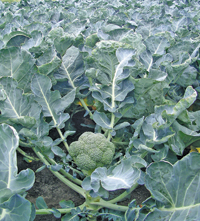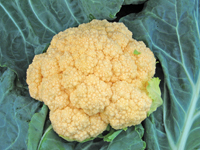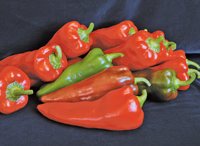
Features
Fruit
Production
Pairing new vegetable varieties with Prairie growing conditions
March 26, 2008 By Myron Love
Saskatchewan’s burgeoning
vegetable production industry is hungry for information on what
varieties will grow successfully under the area’s climactically
challenging conditions.
Saskatchewan’s burgeoning vegetable production industry is hungry for information on what varieties will grow successfully under the area’s climactically challenging conditions.
Every year, numerous new vegetable varieties are introduced, many claiming to be the earliest, the best tasting, and the most vigorous in their category.
“In our trials at the University of Saskatchewan, we try to provide unbiased research results,” says Dr. Doug Waterer, the university’s vegetable specialist. “As the old standard varieties drop away, we are trying to find alternatives that are quality performers with strong market potential.”
The University of Saskatchewan conducts variety evaluation trials on an average of 10 different vegetable crops each year, explains Dr. Waterer.
“We test varieties from anywhere. But we prefer to focus on the varieties available from accessible seed suppliers.”
The resulting data is then shared with seed companies, commercial growers, local garden centres and the gardening public.
In 2006, the University of Saskatchewan conducted trials with asparagus, cabbage, corn, garlic, melons, onions, spinach, turnips, tomatoes and watermelon.
The melon and corn trials had great results, Dr. Waterer reports, but a severe maggot infestation prevented the collection of any useful data from the turnip trial. Researchers also experimented with different colours of Swiss chard, different varieties of green kale, Imperator-type carrots and ornamental corn. A number of heritage-type tomato varieties were also tested but the resulting crop was unimpressive in taste and had an unattractive appearance, Dr. Waterer adds.
According to the university’s results, it was a fantastic year for watermelon production in the province
“Yields and quality were great this year,” Dr. Waterer says, although he adds many of the watermelon varieties produced fruit so full of sugar, the melons broke open during harvest and handling.
 |
| Iron Man |
 |
| Cheddar |
 |
| Carmen |
 |
| Apprentice |
Seed companies
Stokes Seeds representative Paul Banks is also interested in helping educate Saskatchewan growers on what vegetable variety options are available to them. He was recently in the province talking to producers.
Weaving through the intricacies of sweet corn varieties can be challenging and Banks spent a large chunk of his time leading growers through the maze of choices available to them. Results from American-based regional and advanced strip sweet corn trials held over the past few years were discussed. Banks, who is based in St. Catharines, Ontario, also described the three basic classes of sweet corn – the sugary SU, the sugar-enhanced SE and the super sweet SH2 varieties – plus their primary uses and any advantages or disadvantages connected to them. He also provided an overview of additional hybrids, including the Triple Sweets and Sweet Generation, adding that the Sweet Breeds are well adapted to cold soil germination and provide high yields.
Banks also covered information about other vegetable varieties, including:
Beans – The global trend is toward a darker green colour and higher fibre content, he noted. Secretariat is the “industry standard,” he says, adding Caprice is more resistant to a wide range of diseases but can’t handle high heat, preferring late summer or fall conditions. The Valentino bean, he says, is one of the highest yielding beans and likes the hotter temperatures.
Broccoli – Diplomat is the top broccoli seller in Ontario, Banks explains, adding it is suitable for both bunching and crown markets and is tolerant to heat and cold. The Emerald and Gypsy varieties are good summer products with Emerald being best for bunching and Gypsy for crowns, he says. The late maturing, crown-type variety Iron Man was introduced last year and Banks suggests it probably matures too late for prairie growers.
Cabbage – The earliest ripening cabbage, he says, is the BC-63 variety. He adds that the hybrid Bourbon has replaced Balbro while Atlanta is an early maturing Savoy variety. The early-maturing hybrid Tobia, Banks notes, is good for sauerkraut processing while the hybrid Quisor has good uniformity.
Carrots – As for carrots, Banks notes that processors are leaning toward longer, fancier carrots and more specialty cuts. New this year is Pursuit, an early jumbo dicer with very good yields and a fairly high sugar content although it has a tendency to crack in cooler weather. Creme Delite is also new this year and is a creamy pale yellow hybrid of Imperator.
Cauliflower – The cauliflower variety called Cheddar contains high levels of beta-carotene and has a milder taste than standard white varieties, Banks says, adding, the variety Whistler does best in summer.
Cucumber – The trend in cucumbers is toward longer fruit with smoother skin, such as the Intimidator variety, Banks says. He also mentions the dark green, early maturing hybrid, Dishon.
Lettuce – In the lettuce area, Banks spoke of Bennett, which he explains was the most popular variety in New Jersey. He also discusses the new variety Red Express, which is red throughout; Odyssey, a dark green butter-head variety for the fresh market and processing, plus Appleby and Raptor, which are Romaine varieties.
Onion – Highlander and Joliet onion varieties have larger bulbs and are best suited to fresh or short storage markets, Banks says, adding that Alpine is a little smaller but is also best in short storage situations.
Pepper – In the pepper family, Banks mentions the Banana Supreme-type Sweet Savanah, which is one of the processing industry’s favourites, he says. The pungent Caribbean Red and hybrids Carmen and Revolution are also popular, he added.
Pumpkin – For pumpkins, Banks mentions Magic Lantern and the hybrids Cannon Ball (which average five pounds), Super Herc (25-35 pounds), Gladiator and Aladdin (both in the 20-30 pound range), Mystic Plys (five to seven pounds), the mini pumpkin Apprentice (one pound), and the white Mini Lil Pum-ke-mon, which is white with orange stripes.
Tomatoes – Banks also went over different varieties of hybrid grape (Sweet Heart and Smarty) and cherry tomatoes (Cherry Pie and Camilia) plus Royal Roma #9864, the hybrid Crista and the new Scarlet Red.
Print this page